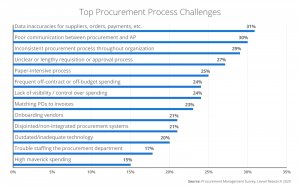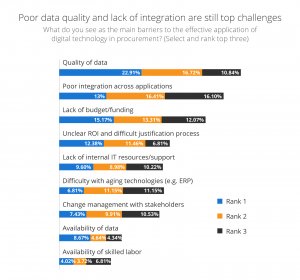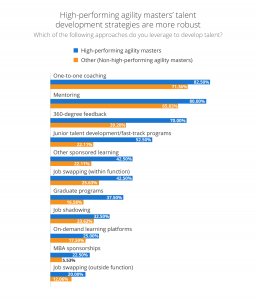Each day, tens of millions of dollars are lost due to inefficiencies in procure-to-pay systems. Dealing with source-to-pay providers effectively is one area where the majority of small to medium businesses stand to realize huge savings, which can come from reduced errors, greatly increased budget visibility, and vastly less manpower to handle procurement and accounts payable tasks.
The best way for businesses to improve efficiency in procuring needed services, materials, goods and subsequently paying for them, involves implementing procure-to-pay software solutions. These solutions tend to be highly specialized. Unfortunately, this means that selecting suitable procure-to-pay solution providers is often considerably more complex than the selection of off-the-shelf business applications.
When considering your own options, it is vitally important that you assess your organization’s biggest challenges within both procurement and accounts payable. According to Levvel Research, inaccurate data, poor coordination between AP and procurement, inconsistent processes, and unclear lengthy processes rank amongst the biggest pain points within the procurement process.

Knowing exactly what your organization’s biggest challenges are allows you to determine whether a definite need for automation exists. It will also help form the list of questions to ask prospective procure to pay solution providers so that you ultimately end up with the most suitable solution for your organization.
Your business has recognized the need for automation, now it’s time to select your software
While almost every business can significantly benefit from procurement and accounts payable automation, coming to grips with this reality and then deciding to do something about it can present major challenges.
Implementing an all-encompassing procure-to-pay software system can be highly disruptive to existing company protocols although it doesn’t have to be. Even at small firms, this means that adopting an automated system may seriously alter the way that a few or even dozens of employees perform their jobs. We’ve previously discussed the internal challenges that organizations face when attempting to implement procure-to-pay automation.
A Deloitte survey reveals top procure to pay challenges that CPOs encounter in the process of launching modernization projects in procurement.

Procure-to-pay applications can, therefore, cost more than their nominal price tag, requiring multiple employees to be trained in their use and then needing supervision to ensure full compliance. In fact, according to Deloitte, 36% of companies struggle to acquire and retain talent with the right skills to support the organization’s procurement strategy. Training and education is, therefore, an important component of any automation project. Top-performing companies are investing more in agility and developing talent to bridge the skill gap.

For these reasons, getting full buy-in among both lower-level employees and upper-level managers to implement procure-to-pay systems can be challenging.
Still, the end results are almost always unambiguously worthwhile. Once your company has surmounted the hurdles that stand in the way of across-the-board agreement on the need for implementation, it’s then time to move towards selecting a software system that will meet your needs.
Because of the complexity of such systems, part of shopping around for an appropriate solution will almost certainly involve a demo taking place at your company. This affords an important opportunity to ask questions that will help differentiate between those delivering world-class software that meets your company’s requirements and procure to pay service providers that simply do not meet your requirements.
While there will always be the obvious questions around pricing and implementation times, here are four questions that every organization should ask potential source to pay providers during a demonstration of their software.
Questions to ask procure-to-pay solution providers
1. Does the software allow for fully automated processing of all invoice formats?
The entire purpose of a procure-to-pay solution is to streamline processes while saving time and money through automating otherwise labor-intensive tasks.
One of the most important ways that procure-to-pay solution providers can do that is by ensuring that all invoice formats can be processed without employees having to resort to manual interventions.
Many procure-to-pay solution providers will try to gloss over their systems’ shortcomings by emphasizing how great the system works when all invoices are sent in a recognized electronic format where the data is pre-structured for easy use by the system. However, it is totally unrealistic to assume that all invoices will be in XML or EDI format as soon as the system is implemented.
In fact, it’s a very good bet that many invoices, especially those from smaller, unsophisticated suppliers, will never be sent in machine-friendly formats. This is where the rubber meets the road for procure-to-pay solution providers, separating the pros from the cons.
The best procure-to-pay solution providers will be able to demonstrate that their systems can handle invoices in all formats, including PDF and old-fashioned paper, extracting the relevant data and structuring it for use within the system. We previously discussed the power of OCR software in scanning and capturing data from invoices in a variety of formats.
2. Does the system allow for line-item requisitioning?
When a purchaser needs to requisition multiple items on the same order, it is important that procure-to-pay solution providers accommodate multiple asynchronous purchase-order approvals without stalling the entire order.
While this may seem like an obvious point, it turns out that many procure-to-pay systems are set up in a way such that if 15 items are ordered at one time, the entire order is held up until each item has been approved by the relevant manager. This is hugely inefficient. All procure-to-pay systems should allow for flexible invoice approval workflows that don’t tie up orders unnecessarily.
3. Does the procure-to-pay system offer real-time budget visibility?
One of the greatest benefits of implementing a fully automated procure-to-pay system is the visibility that it affords. Maverick spending, order volumes for the highest-demand items, and inventory leakage can all be brought into the light and laid bare before the eyes of management through the availability of spend analysis reporting.
This ability alone can often pay for the cost of the procure-to-pay system. However, it is extremely important that visibility be available on-demand and in real-time, not just at the end of the month in summary reports.
Being able to see how requisitions and purchase orders are directly affecting the budget as orders are placed is a powerful tool that can help managers better understand their budgets while eliminating wasteful spending. Seeing these factors at the end of the month, long after the purchase orders were originated, leaves money on the table that should be in the company’s bank accounts instead.
4. Is the system implemented as a multi-tenant solution?
When it comes to upgrades and updates, you definitely want everyone in your organization to be operating from the same version. This generalizes to all of the software’s customers. Ideally, all clients should be of the same version, and procure-to-pay solution providers should have one copy of the source code. A streamlined solution that differs only by pre-configured permissions based on individual users or departments is something organizations should strive for.
The multitude of problems that arise when this is not the case often has serious implications for the usability of the software. For example, users whose clients have not been upgraded may be continuing to rely on a version that has serious bugs. And companies that have dozens or even hundreds of outstanding versions of their software are often unable to provide effective support, which can be crucial in a full and successful implementation of procure-to-pay automation.
A demo shouldn’t just showcase a program’s greatest strengths
When participating as a prospective customer in a procure-to-pay software demonstration, it’s important not to allow yourself to be dazzled by a showcasing of the program’s strongest points. By asking the tough questions and making sure the solution will hold up under real-world stresses, you will be well on your way to a successful procure-to-pay implementation.



